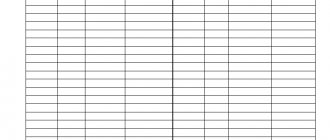Why keep accounting documents?
Any accountant knows that every document drawn up in a company or received from counterparties has its own value and must be preserved.
Based on the information contained in the primary documents, accounting is carried out and financial statements are prepared. Verification of accounting and accounting data by all regulatory authorities is carried out using primary documents. All primary accounting records and reports must be stored for legally defined periods.
The storage periods for accounting documents are regulated by the Law “On Accounting” dated December 6, 2011 No. 402-FZ and the approved list of storage periods.
To learn about what groups documents arising in the activities of an organization are divided into and what their storage periods may be, read the article “Basic storage periods for documents in an organization (archive).”
What documents need to be kept
- If an entrepreneur works with VAT on a common system, then the storage of accounting documents, tax accounting data, any documentation on income received and expenses necessary for calculating taxes, as well as documents confirming tax payments already made must be stored for at least 4 years .
- Accounting statements and primary accounting documents must be stored for at least 5 years.
- An individual entrepreneur must keep all primary accounting and registration documents for individual entrepreneurs, the book of income and expenses (KUDiR) for at least 4 years.
- Documents confirming the payment of insurance contributions to the Pension Fund (PFR), Social Insurance Fund (FSS) and the Compulsory Health Insurance Fund (MHIF) must be kept for 6 years.
- Personal files and cards of employees, including those temporarily hired, employment contracts with employees, documents on dismissal and hiring must be kept for 75 years.
- The labor inspectorate may require any documents on the basis of which you pay wages, bonuses, vacation pay, benefits, and count length of service.
What is more important - the list or law No. 402-FZ
Comparing the storage periods for accounting documents specified in the list and Law No. 402-FZ, the following conclusions can be drawn:
- the list establishes different storage periods depending on the type and significance of documents classified as accounting;
- Law No. 402-FZ provides for a 5-year storage period for accounting documents, but does not specify the terms by type of documentation;
- in paragraph 1 of Art. 29 of Law No. 402-FZ states that the basis for determining the storage periods for documentation is a list.
Thus, when deciding the fate of an invoice, balance sheet or accounting certificate, it is necessary to proceed primarily from the deadlines indicated in the list. However, their storage period cannot be less than 5 years.
The storage period for accounting documents specified in Art. 29 of Law No. 402-FZ, also concerns the accounting policies and standards of the company, including documents existing in electronic form. The latter also cannot be destroyed within a 5-year period. The storage period begins with the year following the year of their last use (Clause 2, Article 29 of Law No. 402-FZ).
Let's understand deadlines using an example
Landscape Design LLC, formed several years ago, has steadily gained a foothold in its market segment. The accounting part of the work was carried out by a team of 4 people. Each specialist was assigned specific accounting areas, and the chief accountant was in charge of reporting and interaction with controllers.
Over the past period of accounting work, countless folders with documentation have accumulated in closets and utility rooms. It's time to deal with them.
Most of the primary data were acts of work performed - on their basis, the company’s revenue was regularly determined, reflected in its financial statements.
Read about the preparation of certificates of completed work in this article .
Significant volumes of paper deposits consisted of invoices for purchased materials, payment slips, salary slips and related calculations.
A separate shelf was completely filled with accounting records, declarations, reports to the pension fund and social security, as well as statistical forms.
Each accountant compiled a list of cases with accounting documentation for his area, and the chief accountant systematized all the information in a single table, one of the columns of which was dedicated to the standard storage periods for documents taken from the list.
Table “Retention periods for accounting documents in an organization”
| Document from Landscape Design LLC | Shelf life according to the list |
| Certificates of work performed under contracts for core activities | Within 5 years after the end of the term for which the contract was concluded |
| Treaties and additional agreements thereto | Within 5 years after expiration (unless otherwise specified in specific items of the list) |
| Powers of attorney for receiving money and goods and materials | At least 5 years after the expiration of the power of attorney or its revocation |
| Statements for the issuance of salaries, benefits, financial assistance and other payments | At least 6 years (from 02/18/2020, previously the period was 5 years) In the absence of personal accounts: 50 years - if the documents were completed after 01/01/2003; 75 years old - if documents were completed before 01/01/2003 |
| Register of information on the income of individuals | At least 5 years (from 02/18/2020, previously the period was 75 years) |
| Employment contracts and personal cards of employees | No less than: 50 years - if the documents were completed after 01/01/2003; 75 years old - if documents were completed before 01/01/2003 |
| Time sheets, working time logs | At least 5 years (at least 75 years under dangerous, difficult and harmful working conditions) |
| Information about the income of individuals | At least 5 years In the absence of personal accounts: 50 years - if the documents were completed after 01/01/2003; 75 years old - if documents were completed before 01/01/2003 |
| Annual accounting (financial) statements | Constantly* |
| Accounting policies, chart of accounts, forms of primary accounting documents | At least 5 years |
| General ledger, turnover sheets, account cards, etc. | At least 5 years |
| Fixed asset accounting cards | At least 5 years after disposal of the object |
| Declarations (calculations) for all types of taxes | At least 5 years |
| Calculations for insurance premiums (annual and quarterly) | 50 / 75 years |
| Information submitted to the Pension Fund for individual (personalized) accounting | At least 5 years, in electronic form - 75 years |
| Reporting to statistics: – annual and more frequently, one-time; – semi-annual and quarterly; – monthly – ten-day, weekly | - Constantly*. – 5 years or permanently* in the absence of annual ones. – 3 years or constantly* in the absence of annual, semi-annual, quarterly. - 1 year |
| Correspondence about penalties and fines imposed on the company | At least 5 years |
Do not ignore the * sign in the table. It means that the document must be kept for the entire time the company operates.
All documentation indicated in the table directly or indirectly relates to accounting, therefore, the chief accountant of Landscape Design LLC increased the periods exceeding the 5-year storage period provided for by Law No. 402-FZ to the limits indicated in the list.
Considering that the company has not yet celebrated its 5th anniversary since the start of work, none of the documents presented in the table can be destroyed. To clear out the paper-cluttered premises, the accounting department allocated a special office, where they placed documents awaiting expiration.
See also “The Ministry of Finance reminded how long primary materials need to be stored.”
For more information about the storage periods for tax documentation, documents on insurance premiums, including accident insurance premiums, see the Ready-made solution from ConsultantPlus.
Retention periods for personnel documents
Personnel documents completed after January 1, 2003 must be stored for 50 years (Clause 2, Article 22.1 of Law No. 125-FZ). This is the period that applies to employment contracts, as well as all additional agreements to them, including termination agreements; personal files and personal cards of employees (Articles 435, 444, 445 of List No. 236).
Also, all orders and instructions regarding personnel, including documents (memos, certificates, statements) to them, are stored for at least half a century. We are talking about orders for admission, transfer, relocation, combination, part-time work, dismissal, remuneration, certification, advanced training, assignment of class ranks, ranks, titles, encouragement, awards, changes in biographical data, parental leave, leaves without pay (Article 434 of List No. 236). A similar storage period also applies to original personal documents (work book, diplomas, certificates, certificates) that were not claimed by employees upon dismissal (Article 449 of List No. 236).
Draw up local acts using ready-made templates and prepare all personnel reports
IMPORTANT
A half-century storage period is also established for civil contracts with individuals, as well as acts on them (Article 301 of List No. 236).
There are exceptions to the general rule. For example, documents related to the application of disciplinary sanctions can be destroyed after three years (Articles 454 and 434 of List No. 236). The same storage period is defined for vacation schedules (Article 453 of List No. 236) and consents to the processing of personal data. True, in the latter case, the countdown of the three-year period begins after the expiration of the consent or its revocation (Article 441 of List No. 236). Please note that this concession does not apply to basic documents (regulations or instructions) on the processing of personal data. They must be stored permanently (Article 440 of List No. 236). You will also always have to take care of orders, instructions and other personnel documents related to the main activity (Article 19 of List No. 236). For example, such documents include orders on approval of the structure of the organization, on the creation of divisions (branches), on taking office, on assigning the duties of the chief accountant to the manager, on early resignation, on the appointment of responsible persons, on the approval and implementation of LNA.
A five-year preservation period is established for work time sheets (if working conditions are dangerous or harmful, this period increases 10 times), orders, instructions and other documents on administrative and economic issues (Articles 402 and 19 of List No. 236). A similar period is allocated for storing orders for the provision of annual paid and educational leave, as well as orders for sending on business trips for workers not engaged in work with harmful and dangerous working conditions. If the work is “harmful,” then orders for business trips cannot be destroyed for 50 years (Article 434 of List No. 236).
Compose HR documents using ready-made templates for free
In addition, copies of reports, applications, lists of employees, certificates, extracts from protocols, conclusions, correspondence and other documents on the payment of benefits, payment of sick leave and the issuance of financial assistance are kept for five years (Article 298 of List No. 236). But payrolls and documents for them, payslips for the issuance of wages, benefits, fees, financial assistance and other payments will have to be preserved for a year longer - for six years (Article 295 of List No. 236).
ATTENTION
Pay slips and payslips should be kept for six years only if the employer maintains personal accounts for employees. Otherwise, these documents must remain preserved for 50 years (Article 295 of List No. 236).
Calculate your salary and benefits according to current rules Calculate for free
Nuances of accounting for storage periods of accounting documentation
In the practical activities of Landscape Design LLC, there were cases of selling fixed assets at a loss. For the purposes of accounting and tax accounting for fixed assets, the same documents are used. The difference lies only in the recognition of expenses associated with their disposal. This fact must also be taken into account when determining the storage period for documents.
For example, 2 years ago the company purchased a VAZ-21102 car (OKOF code 15 3410010). Based on the fact that, according to the classification of the fixed asset, it belongs to the 3rd depreciation group, the useful life (USI) was set at 5 years. Due to constant breakdowns, it was decided to sell the car at any price offered. The proceeds from the sale turned out to be less than the residual value of the property, and the loss from the sale according to tax accounting standards for 3 years (the remaining SPI) will be evenly taken into account when calculating income tax.
IMPORTANT! The nuances of tax accounting for losses from the sale of fixed assets are reflected in clause 3 of Art. 268 Tax Code of the Russian Federation.
Read about the specifics of grouping expenses for tax accounting purposes in this material .
Thus, all documents related to the formation of the initial and residual value, the term of the joint venture investment, contracts and acts of sale, as well as certificates and calculations for accounting for losses from the sale of fixed assets must be preserved for at least 4 years after the end of inclusion of the specified loss in the tax base . This is due to the fact that during an audit, tax authorities have the right to examine documents for the 3 years preceding the audit. Thus, documents on the specified fixed asset will have to be stored for at least 9 years.
The case considered is not the only one where the storage period for documents is extended. In the next section we will present other situations.
Features of calculating deadlines by an entrepreneur
When an individual entrepreneur applies a simplified tax regime and pays income tax (6%), there are no special nuances when determining the storage period for documents - according to the Law “On Accounting” dated December 6, 2011 No. 402-FZ, if there is an income book, other accounting documents are not required to be drawn up , as well as accounting (letter of the Ministry of Finance dated October 17, 2014 No. 03-11-11/52522). Consequently, the entrepreneur will only have to comply with the storage periods for tax documents established by the Federal Archive. For books, these periods are calculated from January 1 of the year following the year in which their maintenance was completed. Since KUDIR opens for a year, the deadline will start next year. That is, for a book for 2021 it will last from 01/01/2021 to 12/31/2025.
It’s another matter if an individual entrepreneur applies a general regime or a simplified one with the “income minus expenses” base and regularly transfers previously received losses - to justify the transfer amounts (as well as the loss itself), documents will have to be stored for a longer time. This period for the simplified tax system can be 15 years (taking into account the permissible 10-year transfer period and the standard shelf life of the book), and with OSNO it can even exceed this limit, since in order to take into account the loss when calculating income tax, there are no restrictions on the number of years of write-off (Art. 283 of the Tax Code of the Russian Federation).
For information on what storage periods are established for certain types of documents, read the article “What are the storage periods for documents according to the nomenclature of files?”
Other cases of increasing the shelf life of primary products
If Landscape Design LLC operated with a loss, and then took it into account when calculating income tax, the documents would have to be kept for the entire period of transferring the loss plus 4 years after it was completely written off. In this case, it is impossible to get rid of either the primary document confirming the loss received, or other certificates and calculations on the basis of which this loss was transferred.
For example, accounting and tax documents for losses incurred in 2021 and taken into account over the next 10 years will have to be stored until the end of 2033.
Read more about the nuances of accounting for losses in the article “How and for what period can losses be carried forward?” .
The storage period for accounting documents will also have to be increased in the following case. Landscape Design LLC provided services to a customer who did not promptly pay for the work performed and did not respond to letters and complaints. The company was not excluded from the state register, but did not repay its debt. Landscape Design LLC was able to take into account bad receivables only in 2021, and all documents of the organization related to this situation will have to be stored until the end of 2023.
Liability and fines
For failure to comply with legal requirements regarding the safety of documentation, significant penalties are provided. Article 120 of the Tax Code of the Russian Federation establishes the following fines if the rules and terms of storage of primary documentation have been violated:
- 10,000 rubles if the company did not provide accounting and tax documents relating to one tax period, that is, a fine is issued for the fact that the company did not keep accounting and tax records during the tax period;
- 30,000 rubles if a similar violation was detected in several reporting periods at once;
- 40,000 rubles (minimum) or 20% of the amount of unpaid tax, if missing documentation led to an understatement of the tax base.
In addition to fines for a legal entity, tax authorities can also fine the manager. For example, a fine of 2,000 to 3,000 rubles for the director of an organization in which the rules and terms of storage of primary data were violated (Article 15.11 of the Code of Administrative Offenses of the Russian Federation).
Results
Invoices, certificates of work performed, salary payment statements, reports - taxpayers are required to keep these and many other accounting documents for the periods established by a special list. These terms cannot be reduced, but in some cases they have to be increased (when carrying forward losses, writing off bad receivables, selling fixed assets at a loss).
Sources:
- Federal Law of December 6, 2011 No. 402-FZ
- Order of Rosarkhiv dated December 20, 2019 No. 236
You can find more complete information on the topic in ConsultantPlus. Free trial access to the system for 2 days.







